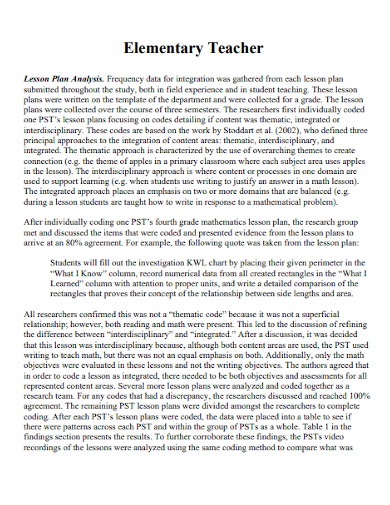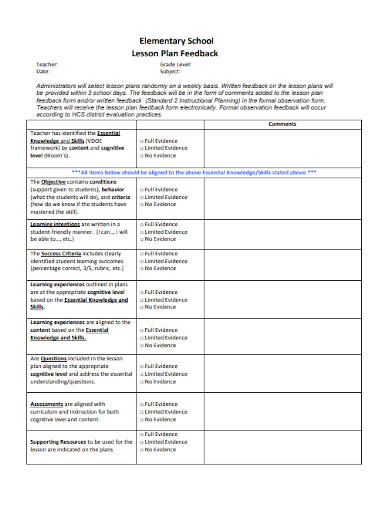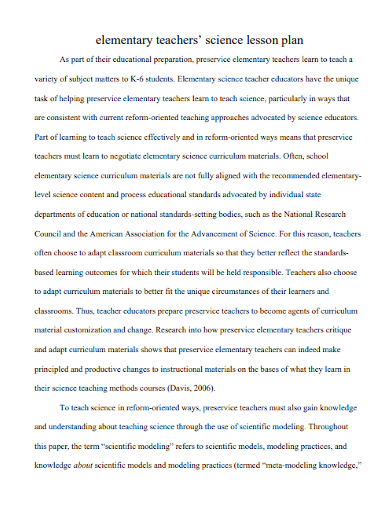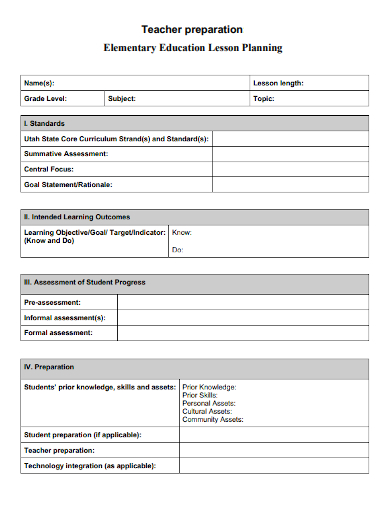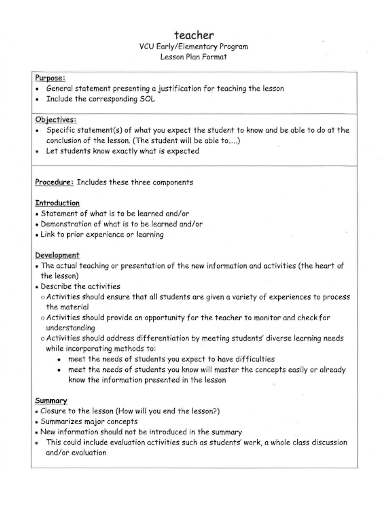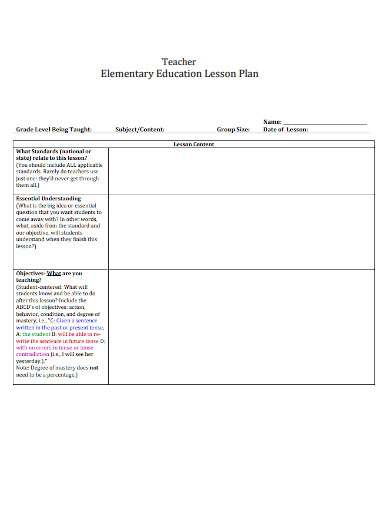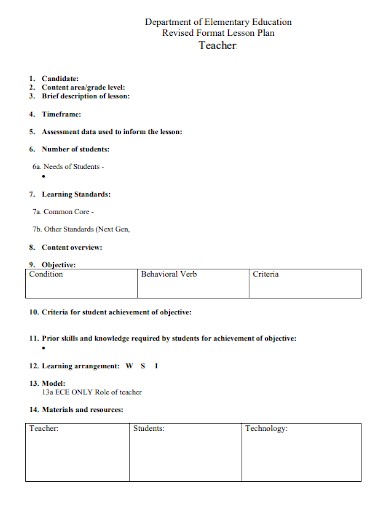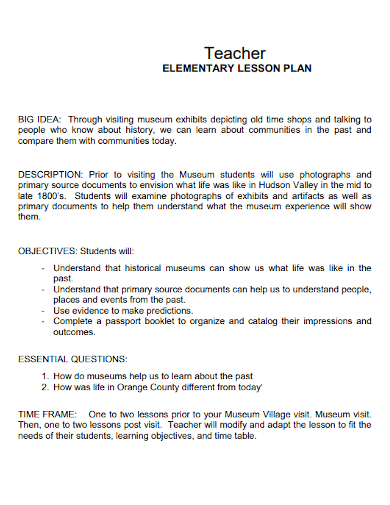Part of a teacher‘s responsibility is to create a lesson plan. A lesson plan provides them with a general outline of their teaching goals, learning objectives, and methods in achieving those. Even though making a lesson plan is extensive and oftentimes exhausting, it helps teachers organize and plan on what appropriate lessons they will be teaching to their students. It also helps them to screen whether or not their students are learning effectively from the lessons they teach. This article will guide you on how to make a lesson plan for your elementary students.
10+ Elementary Teacher Lesson Plan Samples
1. Elementary Teacher Lesson Plan Template
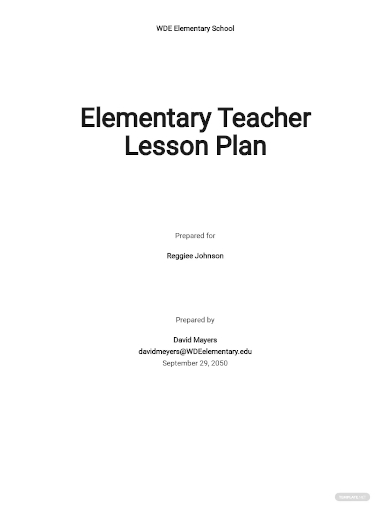
2. Elementary Teacher Lesson Plan Analysis
3. Elementary School Teacher Lesson Plan Feedback
4. Elementary Teachers Science Lesson Plan
5. Elementary Teacher Bathroom Lesson Plan
6. Elementary Education Teacher Preparation Lesson Plan
7. Early Elementary Program Teacher Lesson Plan
8. Elementary Education Teacher Lesson Plan
9. Department of Elementary Revised Teacher Lesson Plan
10. Sample Elementary Teacher Lesson Plan
11. Elementary Reading Kindergarten Teacher Lesson Plan
What is a Lesson Plan?
A lesson plan serves as a road map for teachers that outlines what the students need to learn in a subject area and how it will be taught during class. This is also where teachers design appropriate learning activities and develop strategies to get feedback on student learning.
A lesson plan should have these three key components:
- Learning objectives
- Learning activities
- Assessment on student understanding
How to Make a Lesson Plan
1. Identify the Learning Objectives
Before you plan your lesson, you will first need to identify the learning objectives for the lesson that you will be teaching. A learning objective describes what the students should know or be able to do after the lesson is being taught to them. The learning instructions for the learning activities you’ve laid out for the plan should easily be understood by students and must be related to your school’s guide on learning outcomes.
2. Plan Specific Learning Activities
When you plan your learning activities, there are a lot of things that you should consider. For example, you have to consider the types of activities students will need to engage in, to develop the skills and knowledge required to show that they have learned from your lesson. Planning your learning activities can be quite challenging, so here is the list of considerations you can refer to for you to create efficient learning activities:
- Estimation of how much time discussing and working on each activity
- Strategies to use when executing the activity; how to explain them in a way that students can easily understand, how to engage their interests in participating, what tools do students need to further understand the activity and its topic, etc.
3. Plan to Assess Students’ Understanding
Creating assessments of student learning such as tests, essay papers, problem sets, etc. give you the chance to find out if your students are learning something or nothing at all. When you make your assessment, make sure they are efficient enough to give the results you need, refer to the lists below for you to make your assessment:
- The number and types of assessment tasks (either formative or summative)
- The criteria and standards that will be used to make assessment judgments
- Student roles in the assessment process (either self-assessment or peer assessment)
- Combination of all assessment tasks and learning tasks students have done so the teacher can come up with their final grade for the course.
- Providing feedback to students on their performance.
3. Duration
You also need to include in the lesson plan the duration of completing the discussion and learning of a certain lesson. For example, if the lesson plan is for daily classes, it may take the entire length of a typical class period or even extend to the next day to complete the lesson. You also need to adapt your plans according to the learning styles of your students so this is also a factor in the duration of your lessons. Familiarizing with the learning styles of students can help you adjust your lessons to their level of understanding.
4. Materials
This section lists any materials required of the students and you to complete the lesson. Typical materials include specific pages from a textbook, printouts, writing utensils paper, and other materials needed to complete the lesson. List down materials in your lesson plan to help you prepare.
5. Directions
The last section of the lesson plan is including directions for the lesson. Your directions should be specific and should include what you intend to do at the beginning, middle, and end of the lesson.
FAQs
What are the different types of classroom activities?
The different types of classroom activities that do are:
- Interaction with content material
- Interaction with other peers
- Interaction with digital content
- Problem-solving and critical thinking
- Reflection
What are the five types of lesson plans?
- Daily: The duration of this type of plan is the length of one class period each day. As the name suggests, are made every day. Each day has a separate objective and a small assessment at the end of the day to check the students’ understanding of the lessons discussed during the day.
- Weekly: This plan consists of one lesson created to last for the entire week.
- Unit: This type of lesson plan is done way ahead of time that can take anywhere to two months since these lesson plans are more extensive because they cover a wider range of content.
- Content area: Some teachers teach more than one subject each day and each subject needs a lesson plan.
- Grade level: Some teachers teach more than one grade level and they need to create different lesson plans depending on what grade level they are teaching.
After you’ve created your lesson plan, review it first before you use it for your classes. don’t forget to include a section in your lesson where you put your reflection on what strategies worked well and why, what strategies didn’t work, and what you could have done differently. Identifying all of these aspects for your classes would make it easier to adjust to any situation that will happen in the classroom. If needed, you can revise your lesson plan. To help you get started making the lesson plan, download our free sample templates above to use as your guide!
Related Posts
FREE 7+ Fashion Business Plan Samples in PDF
FREE 10+ Sprint Planning Samples In MS Word | Google Docs | PDF
FREE 10+ Wedding Planning Samples in MS Word | Apple Pages | Powerpoint | PDF
FREE 9+ Monthly Study Planner Samples in PSD | Illustrator | InDesign | PDF
FREE 9+ Sample Curriculum Planning Templates in PDF | MS Word
FREE 10+ Teacher Development Plan Samples in MS Word | Google Docs | Apple Pages | PDF
FREE 10+ Basketball Practice Plan Samples in PDF
FREE 12+ School Business Plan Samples in PDF | MS Word | Apple Pages | Google Docs
FREE 7+ Client Strategic Plan Samples in PDF | MS Word
FREE 11+ Trucking Business Plan Templates in PDF | MS Word | Google Docs | Pages
FREE 7+ Small Hotel Business Plan Samples PDF | MS Word | Apple Pages | Google Docs
FREE 14+ Bakery Business Plans in MS Word | PDF | Google Docs | Pages
FREE 4+ Yearly Lesson Plan Samples in PDF
FREE 50+ Strategic Planning Samples in Google Docs | Pages | PDF | MS Word
FREE 10+ Construction Project Plan Samples in MS Word | Google Docs | Apple Pages | PDF

